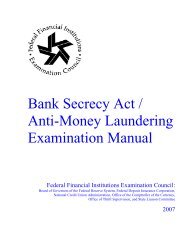FFIEC Annual Report 1999
FFIEC Annual Report 1999
FFIEC Annual Report 1999
Create successful ePaper yourself
Turn your PDF publications into a flip-book with our unique Google optimized e-Paper software.
Task Force on Surveillance Systems meeting.<br />
activities. In particular, the guidance<br />
stresses the specific expectation<br />
that any securitization-related<br />
retained interest claimed and<br />
booked by a financial institution<br />
will be supported by documentation<br />
of the interest’s fair value,<br />
determined by using reasonable,<br />
conservative valuation assumptions<br />
that can be objectively verified.<br />
Retained interests that lack such<br />
objectively verifiable support<br />
or that fail to meet the supervisory<br />
standards set forth in the<br />
guidance will be classified as loss<br />
and disallowed as assets of the<br />
institution for regulatory capital<br />
purposes.<br />
High LTV Residential Real Estate<br />
Lending<br />
In October <strong>1999</strong>, the four banking<br />
agencies issued guidance on high<br />
loan-to-value residential real estate<br />
lending. The guidance discusses the<br />
credit risks associated with such<br />
lending and the controls needed to<br />
manage those risks. The guidance<br />
also clarifies that the agencies’ 1992<br />
real estate lending standards apply<br />
to these transactions.<br />
20<br />
Task Force on Surveillance<br />
Systems<br />
The Task Force on Surveillance Systems<br />
oversees the development and<br />
implementation of uniform interagency<br />
surveillance and monitoring<br />
systems. Historically, the task<br />
force’s primary objective has been<br />
to develop and produce the Uniform<br />
Bank Performance <strong>Report</strong><br />
(UBPR). This report is an analytical<br />
tool created for supervisory purposes.<br />
It is used to monitor the condition<br />
and performance of banking<br />
institutions and to identify potential<br />
or emerging problems in those financial<br />
institutions. A UBPR is produced<br />
quarterly for each commercial<br />
bank and insured savings bank<br />
in the United States that is supervised<br />
by the FRB, the FDIC, or the<br />
OCC.<br />
During <strong>1999</strong>, the Surveillance Task<br />
Force and Surveillance Working<br />
Group completed the following<br />
projects:<br />
Revised the earnings and profitability<br />
analysis to reflect the special<br />
tax status of banks electing<br />
Subchapter S treatment for<br />
income taxes. To improve the<br />
earnings analysis of such banks<br />
the UBPR includes an estimate of<br />
the taxes. This new computation<br />
should enhance bank-to-bank<br />
analysis.<br />
Revised peer group analysis in<br />
the UBPR to reflect line-of-business<br />
peer groups. This addition<br />
is part of an ongoing project to<br />
revamp peer group definitions.<br />
The task force has undertaken<br />
this change to make the peer<br />
grouping used in the UBPR more<br />
reflective of a changing banking<br />
industry.<br />
Revised the risk-based capital<br />
calculation to include regulatory<br />
changes to the treatment of accumulated<br />
gain or loss on cash<br />
flow hedges and made other minor<br />
changes to capital analysis.<br />
Reviewed the combined Call<br />
<strong>Report</strong> proposed by the <strong>Report</strong>s<br />
Task Force and performed an<br />
extensive analysis of all UBPR<br />
ratios to determine impact. Coordinated<br />
survey responses from<br />
state bank supervisors on this<br />
project.<br />
Tested the developmental version<br />
of the project to place the<br />
UBPR on the public web site.<br />
Agency involvement in Y2K<br />
issues resulted in the movement<br />
of final implementation to 2000.<br />
This project was approved by the<br />
Council in 1998.<br />
Produced and distributed four<br />
quarterly versions of the UBPR<br />
ahead of schedule. Each federal<br />
banking agency received UBPR<br />
data in electronic format. State<br />
banking agencies were provided<br />
two sets of printed UBPRs for<br />
banks in their respective states.<br />
It is anticipated that some of the<br />
state banking agencies that are<br />
developing information systems<br />
may ultimately substitute UBPR<br />
data from either web site or tape<br />
delivery for the printed copies<br />
currently provided. Additionally,<br />
printed UBPR reports were<br />
sent to all banks. Several thou-
















